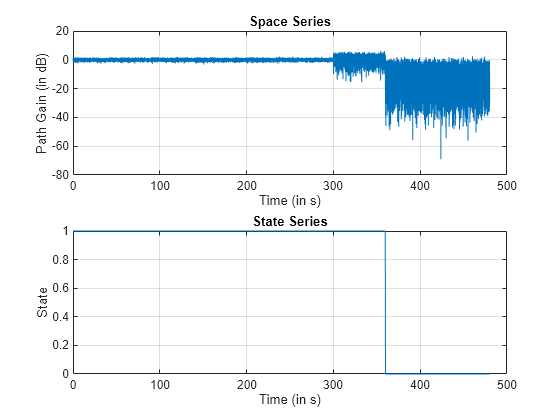lutzLMSChannel
Description
The lutzLMSChannel
System object™ filters a real or complex input signal through a Lutz land mobile-satellite
(LMS) frequency-flat fading communication channel, as defined in [1].
To filter an input signal through a Lutz LMS time-varying channel:
Create the
lutzLMSChannelobject and set its properties.Call the object with arguments, as if it were a function.
To learn more about how System objects work, see What Are System Objects?
Creation
Description
chan = lutzLMSChannel
The default System object parameters are set to a scenario in which the mobile is moving at a constant speed of 3 km/hr on a highway with a conical spiral antenna operating at a 1.54 GHz carrier frequency and a satellite elevation angle of 34 degrees, as specified in [1].
chan = lutzLMSChannel(Name=Value)SampleRate=20e3 sets the input
signal sample rate to 20e3.
Properties
Usage
Description
[
produces path gains, pathgains,sampletimes,stateseries] = chan()pathgains, sample times,
sampletimes, and state series, stateseries for
a Lutz LMS frequency-flat fading channel.
In this case, the System object acts as a source of path gains, sample times, and state series.
Specify the duration of the fading process by using the NumSamples
property. Specify the data type of pathgains and
sampletimes using the OutputDataType property.
Note
This syntax is applicable when you set the ChannelFiltering property to false.
[
filters the input signal, y,pathgains,sampletimes,stateseries] = chan(x)x, through a Lutz LMS frequency-flat fading
channel, and returns the output channel-impaired signal in y, in
addition to the outputs in the previous syntax.
Note
This syntax is applicable when you set the ChannelFiltering property to true.
Input Arguments
Output Arguments
Object Functions
To use an object function, specify the
System object as the first input argument. For
example, to release system resources of a System object named obj, use
this syntax:
release(obj)
Examples
References
[1] Lutz, E., D. Cygan, M. Dippold, F. Dolainsky, and W. Papke. “The Land Mobile Satellite Communication Channel-Recording, Statistics, and Channel Model.” IEEE Transactions on Vehicular Technology 40, no. 2 (May 1991): 375–86. https://doi.org/10.1109/25.289418.
Extended Capabilities
Version History
Introduced in R2022b
